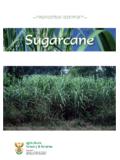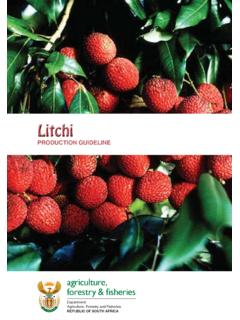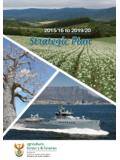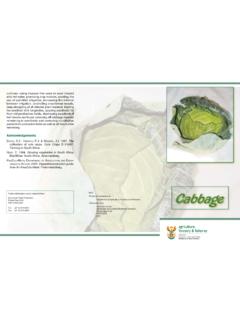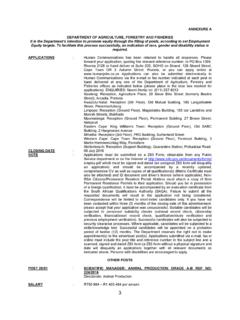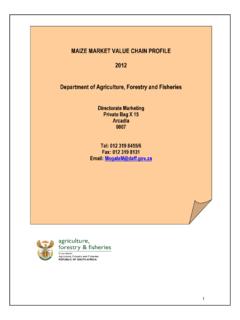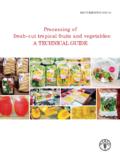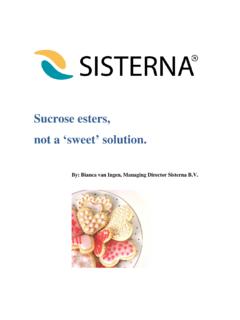Transcription of SUGAR MARKET VALUE CHAIN PROFILE 2011-12
1 A PROFILE OF THE SOUTH AFRICAN SUGAR MARKET VALUE CHAIN . 2011 . Directorate Marketing Private Bag X 15. Arcadia 0007. Tel: 012 319 8455. Fax: 012 319 8131. E-mail: Table of contents 1. DESCRIPTION OF THE INDUSTRY 3. Production Areas 4. Production 5. Employment 7. 2. MARKETING STRUCTURE 7. Domestic MARKET and Domestic SUGAR Prices 7. 3. EXPORTS VOLUMES OF RAW SUGAR 10. Share Analysis 31. 4. IMPORTS VOLUMES OF RAW SUGAR 36. 5. PROCESSING AND MILLING 46. Marketing Arrangements 47. 6. MARKET VALUE CHAIN 48. 7. MARKET ACCESS 49. Tariffs 49. 8. MARKET INTELLIGENCE 53. 9. ORGANIZATIONAL ANALYSIS 64. Empowerment and Transformation 64. Business Opportunities and Challenges 64. 10. SUGAR MILLERS IN SOUTH AFRICA 65. 11. ACKNOWLEDGEMENTS 69. 1. DESCRIPTION OF THE INDUSTRY.
2 The South African SUGAR industry makes an important contribution to the national economy, given its agricultural and industrial investments, foreign exchange earnings, its high employment and linkages with major suppliers, support industries and customers. It is a diverse industry combining the agricultural activities of sugarcane cultivation with the industrial factory production of raw and refined SUGAR , syrups and specialized sugars, and a range of by-products. The industry produces an estimated average of million tons of SUGAR per season. About 60% of this SUGAR is marketed in the Southern African Customs Union (SACU). Based on revenue generated through SUGAR sales, in the SACU region and world export MARKET , the South African SUGAR industry is responsible for generating an annual average direct income of R8 billion.
3 The industry contributes an estimated average billion to the country's foreign exchange earnings on an annual basis. The average annual VALUE of sugarcane production is R4 billion, which is more than 15% of the total gross VALUE of annual field crop production. Its support to the domestic VALUE CHAIN is estimated at R96 million. The SUGAR industry's contribution to the South African economy can be described as follows;. The South African SUGAR industry makes an important contribution to the national economy, given its agricultural and industrial investments, foreign exchange earnings, its high employment, and its linkages with major suppliers, support industries and customers.. The industry accounts for % of total merchandise exports by VALUE , of total income tax, or total fixed capital stock of business enterprises, and of salaries and wages.
4 This proportion is above the average of for all sectors in the economy, but similar to that for the agriculture, clothing, textiles and footwear, and accommodation and catering sectors;. The SUGAR industry directly supports approximately 79 000 jobs, and indirectly supports another 350 000 jobs. Approximately one million people, more than 2% of South Africa's population depends on the SUGAR industry for a living. The South African Sugarcane Research Institute, through its research and development activities, contributes significantly to the development of the SUGAR industries of Sub- Saharan Africa, and it produces most of the varieties of cane grown in Africa south of the equator;. The SUGAR Milling Research Institute is regarded internationally as a leader in its field of research, training and consultancy.
5 The industry is regulated in terms of the SUGAR Act and the SUGAR Industry Agreement, which are binding on all sugarcane growers and producers of SUGAR products. The contribution of the SUGAR industry to the Gross VALUE of Agricultural production can be summarized in Figure 1. Figure 1: Gross VALUE of SUGAR Production 6000000. 5000000. Gross VALUE (Rands). 4000000. 3000000. 2000000. 1000000. 0. '02. '03. '04. '05. '06. '07. '08. '09. 10. '11. 20 09/'. 20 01/. 20 02/. 20 03/. 20 04/. 20 05/. 20 06/. 20 07/. 20 08/. 20 10/. Period (Years). Source: Statistics & Economic Analysis Figure 1 indicates gross VALUE of SUGAR production in South Africa between 2001/02 and 2010/11. period. The graph further indicates that gross VALUE of SUGAR production started to increase in 2001/02 to 2002/03 marketing season, followed by a decrease from 2003/04 and 2004/05.
6 A. consistent increase in gross VALUE of SUGAR production from 2005/06 to 2009/10 was due to a significant increase in production of the crop over the same period. The SUGAR cane's contribution to the gross VALUE of agricultural production increased significantly from 2005/06 to 2009/10 and this was due to a consistent increase in SUGAR cane producer prices during the aforementioned period. The decline in the contribution of SUGAR to the gross VALUE of production between 2003/04. and 2004/05 can be attributed to a strong rand against the dollar which had a reducing effect on producer prices of SUGAR cane. Rainfall across the entire industry was below expectation up to 2004/05 season resulting in the smallest crop since 1995/96. The slight decline in the contribution of SUGAR to the gross VALUE of SUGAR production in 2010/11 can be attributed to a strong rand against the dollar which had a reducing effect on producer prices of SUGAR cane during that period.
7 Production Areas Sugarcane in South Africa is grown in 14 cane producing areas extending from Northern Pondoland in the Eastern Cape Province through the coastal belt and Kwazulu-Natal midlands to the Mpumalanga Lowveld. Of the 430 000 ha currently under sugarcane, about 68% is grown within 30km of the coast and 17% in the high rainfall areas of Kwazulu-Natal. The balance is grown in the northern irrigated areas that comprise Pongola and Mpumalanga lowveld. Production On average million tons of sugarcane is produced each season from 14 mill supply areas, extending from Northern Pondoland in the Eastern Cape to the Mpumalanga Lowveld. Of the 29. 130 registered sugarcane growers 27 580 are small-scale growers mainly on tribal land of whom 13 871 delivered cane for crushing in 2010/11, accounting for of the total crop.
8 With the focus on empowerment of previously disadvantaged people, a growing number of black growers are entering sugarcane farming on commercial farms made available at MARKET related prices by the major milling companies and other sellers of freehold land. Post 1994 purchases of freehold land created more than 1300 black commercial growers in the SUGAR industry, who own 40 000. hectares, or 11% of freehold land under sugarcane. An additional 70 000 hectares of land under sugarcane is already being farmed by small-scale black growers on tribal land. In total there are 1. 550 commercial growers (inclusive of the more than 378 new black commercial growers) who produce of total sugarcane production. Milling companies with their own SUGAR estates produce of the crop.
9 The percentage of these millers-cum planter estates has decreased in recent years is likely to continue doing so as the companies promote black farming development. Figure 2: SUGAR cane production in South Africa - 2010. 8%. 7%. 85%. Large scale growers SUGAR estates Small scale growers Source: South African SUGAR Association Figure 2 shows that during the period under review, large scale growers contributed % of the crop, small scale growers contributed and SUGAR estates contributed Table 1: Total crop area under sugarcane (ha) between 2001/02 and 2010/11. Period of Years Hectares ( 000). 2001/'02 431771. 2002/'03 430106. 2003/'04 426861. 2004/'05 424907. 2005/'06 423960. 2006/'07 419463. 2007/'08 412979. 2008/'09 413566. 2009/'10 391483. 2010/'11 383 000.
10 Source: South African SUGAR Association (SASA). Table 1 depicts the total crop area under SUGAR cane in hectares between 2001/02 and 2010/11. period. The table further depicts that the area owned by large scale growers decreased from 431. 771 to 383 000 ha between 2001/02 and 2010/11 period as indicated in table 1 above. The table also depicts that there were fluctuations in terms of the hectares that were allocated for SUGAR cane during that period. Again in 2009/10 there was a huge decline in terms of the hectares that were allocated to sugarcane growing to a level closer to the 2010/11 season. Table 2: Sugarcane: area planted, cane production and SUGAR production Year 2001 2002 2003 2004/ 2005/ 2006/ 2007/ 2008/ 2009/ 2010/. /02 /03 /04 05 06 07 081 09 10 11.
